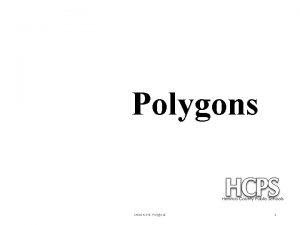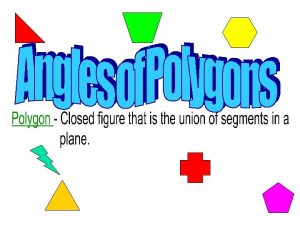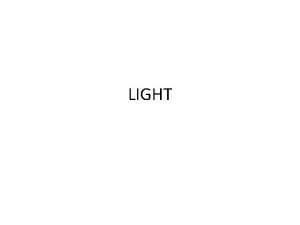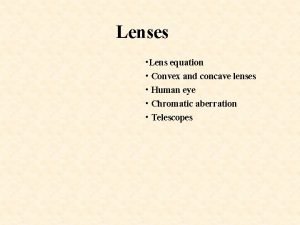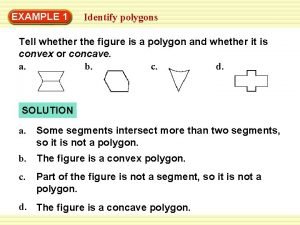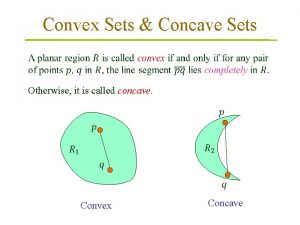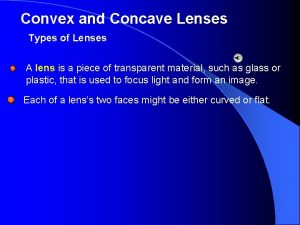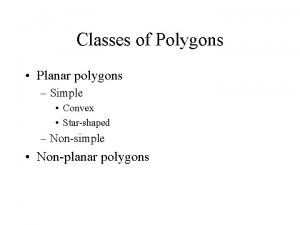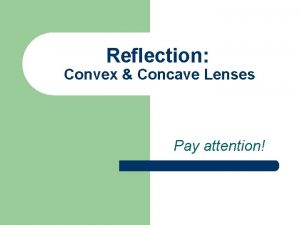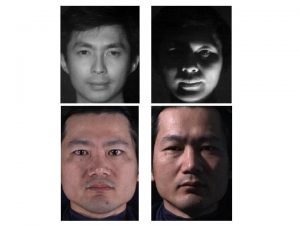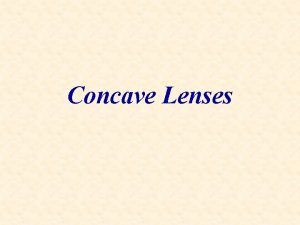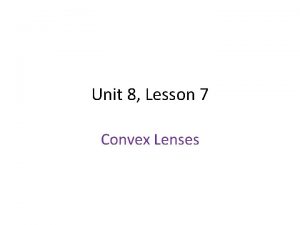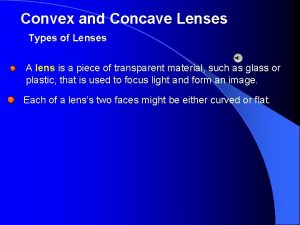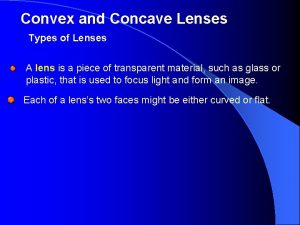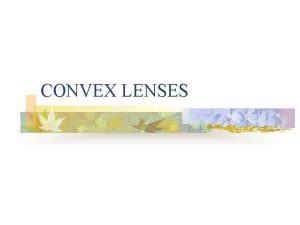Reflection Convex Concave Lenses Pay attention The Law












- Slides: 12

Reflection: Convex & Concave Lenses Pay attention!

The Law of Refraction l l Regardless of whether we are dealing with a concave (thinner at center) lens or a convex (thicker at center) lens, the law of refraction still holds… na • sin(θa) = nb • sin(θb) … where θa is the angle of incidence from one medium and θa is the angle of refraction into a second medium

Let’s put the “fizz” back into Fizzics! n n Let us first remember that all lenses have a focal point (F). Positive F for convex (thicker at center) lenses, and negative F for concave (thinner at center) lenses. (Just the OPPOSITE of mirrors. ) n n The focal length (f) is equal to ½ the radius of curvature (R). This means f = ½R. “R” measures from the center (C) of a circle to it’s surface. Thus F = ½C, which means 2 F = C.

Convex Lenses n n n Have a “belly” since they are always thicker at center. Usually converge light and thus have images appear on the side opposite to the object. Convex lenses have a positive focus. biconvex plano-convex concavo-convex

An example… o 1 st: Determine which focus to use: o 2 nd: POA o 3 rd: From Head to lens: o 4 th: From Head through middle of lens: objects are ALWAYS positive, and images are positive on the side opposite to the object, so mark your positive and negative sides right away parallel to POA to middle of lens, and then through the focus of lens – F real because the image is on the positive side formed with converging rays the image inverted because points in the opposite direction as if refracted equally as straight line REMEMBER: It must go through POSITIVE focus since this is a convex lens! +F 2 F larger equal imaginary real The image is thus… erect smaller (negative) (positive) s vr inverted 2 F Principal Optic Axis : from the base of object through the Focus (F) and Center (C or 2 F) to middle of lens

Another example… o 1 st: Determine which focus to use: o 2 nd: POA o 3 rd: From Head to lens: o 4 th: From Head through middle of lens: objects are ALWAYS positive, and images are positive on the side opposite to the object, so mark your positive and negative sides right away Principal Optic Axis : from the base of object through the Focus (F) and Center (C or 2 F) to middle of lens parallel to POA to middle of lens, and then through the focus of lens REMEMBER: It must go through POSITIVE focus since this is a convex lens! +F –F real because thethe image is on inverted because image the positive side formed with points in the opposite direction converging rays C larger equal imaginary The image is thus…real erect smaller (positive) (negative) ev r inverted C as if refracted equally as straight line

Another example… o 1 st: Determine which focus to use: o 2 nd: POA o 3 rd: From Head to lens: o 4 th: From Head through middle of lens: objects are ALWAYS positive, and images are positive on the side opposite to the object, so mark your positive and negative sides right away Principal Optic Axis : from the base of object through the Focus (F) and Center (C or 2 F) to middle of lens parallel to POA to middle of lens, and then through the focus of lens as if refracted equally as straight line REMEMBER: inverted because the image It must go through POSITIVE focus since this is a convex lens! points in the opposite direction C +F –F C real because the image is on equal imaginary the positive side formed with The image is thus…real erect smaller (positive) (negative) converging rays lv r larger inverted

Last and unique example… o 1 st: Determine which focus to use: o 2 nd: POA o 3 rd: From Head to lens: o 4 th: From Head through middle of lens: objects are ALWAYS positive, and images are positive on the side opposite to the object, so mark your positive and negative sides right away Principal Optic Axis : from the base of object through the Focus (F) and Center (C or 2 F) to middle of lens parallel to POA to middle of lens, and then through the focus of lens REMEMBER: It must go through POSITIVE focus since this is a convex lens! +F –F imaginary because the image erect because the image NOTICE! The lines diverge and will NEVER is on the side formed points in negative the same direction meet. Therefore, draw them back to where they appear to meet. with virtual converging rays C larger equal imaginary The image is thus…real erect smaller (positive) (negative) lc i inverted C as if refracted equally as straight line

Concave Lenses n n n Form a sort of “cave” since they are always thinner at center. ALWAYS diverge light and thus have images appear on the same side as the object. Convex lenses have a negative focus. biconcave plano-concave convexo-concave

An example… o 1 st: Determine which focus to use: o 2 nd: POA o 3 rd: From Head to lens: o 4 th: From Head through middle of lens: objects are ALWAYS positive, and images are positive on the side opposite to the object, so mark your positive and negative sides right away Principal Optic Axis : from the base of object through the Focus (F) and Center (C or 2 F) to middle of lens parallel to POA to middle of lens, and then through the focus of lens REMEMBER: It must go through NEGATIVE focus since this is a concave lens! But since the negative focus is BEHIND the ray, then it must APPEAR to come from that focus. C as if refracted equally as straight line +F –F The image is thus… C s c i NOTICE! imaginary because the image larger erect because the image Concave rays always produce diverging rays. equal imaginary is on the side formed Therefore, they will ALWAYS produce smaller, erect and imaginary images real erect points in negative the same direction smaller REGARDLESS of where the object is located in relation to the focus, unlike (positive) (negative) with virtual converging rays converging (convex) lenses which can produce four different types of images. inverted

Another example… o 1 st: Determine which focus to use: o 2 nd: POA o 3 rd: From Head to lens: o 4 th: From Head through middle of lens: objects are ALWAYS positive, and images are positive on the side opposite to the object, so mark your positive and negative sides right away Principal Optic Axis : from the base of object through the Focus (F) and Center (C or 2 F) to middle of lens parallel to POA to middle of lens, and then through the focus of lens REMEMBER: It must go through NEGATIVE focus since this is a concave lens! But since the negative focus is BEHIND the ray, then it must APPEAR to come from that focus. C as if refracted equally as straight line +F –F The image is thus… C s c i NOTICE! imaginary because the image larger erect because the image Concave rays always produce diverging rays. equal imaginary is on the side formed Therefore, they will ALWAYS produce smaller, erect and imaginary images real erect points in negative the same direction smaller REGARDLESS of where the object is located in relation to the focus. (positive) (negative) with virtual converging rays Notice that as you get closer to the lens, the images get larger. inverted

Another example… o 1 st: Determine which focus to use: o 2 nd: POA o 3 rd: From Head to lens: o 4 th: From Head through middle of lens: objects are ALWAYS positive, and images are positive on the side opposite to the object, so mark your positive and negative sides right away Principal Optic Axis : from the base of object through the Focus (F) and Center (C or 2 F) to middle of lens parallel to POA to middle of lens, and then through the focus of lens REMEMBER: It must go through NEGATIVE focus since this is a concave lens! But since the negative focus is BEHIND the ray, then it must APPEAR to come from that focus. C as if refracted equally as straight line +F –F The image is thus… C s c i imaginary because the image larger erect because the image NOTICE! equal Unlike convex lenses which CANNOT produce images when an object is located real imaginary is on the side formed points in negative the same at the direction focus, concave lenses WILL produce images, but they are virtual and get erect smaller (positive) (negative) larger as you getrays closer to the lens. with virtual converging inverted
 Concave and convex polygon definition
Concave and convex polygon definition Concave and convex polygon
Concave and convex polygon Convex vs concave teeth
Convex vs concave teeth A lens that curve outwards and are fatter in the middle
A lens that curve outwards and are fatter in the middle Hipermetropy
Hipermetropy Concave lens simulation
Concave lens simulation Concave convex rule
Concave convex rule Decide whether the figure is a polygon
Decide whether the figure is a polygon Elbow rom
Elbow rom Graham scan
Graham scan Concave vs convex polygon
Concave vs convex polygon Convex lens vs concave lens
Convex lens vs concave lens Concave and convex polygon definition
Concave and convex polygon definition
